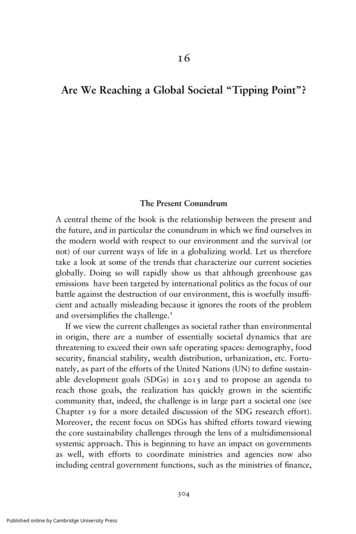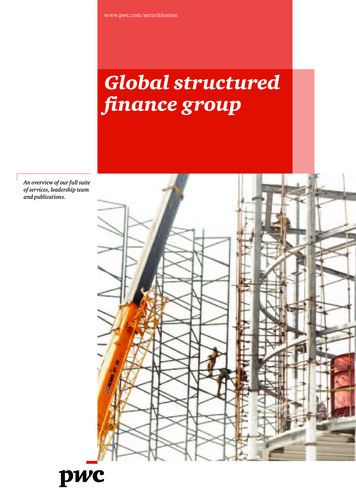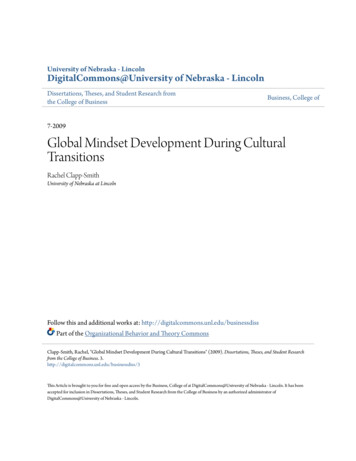
Transcription
16Are We Reaching a Global Societal “Tipping Point”?The Present ConundrumA central theme of the book is the relationship between the present andthe future, and in particular the conundrum in which we find ourselves inthe modern world with respect to our environment and the survival (ornot) of our current ways of life in a globalizing world. Let us thereforetake a look at some of the trends that characterize our current societiesglobally. Doing so will rapidly show us that although greenhouse gasemissions have been targeted by international politics as the focus of ourbattle against the destruction of our environment, this is woefully insufficient and actually misleading because it ignores the roots of the problemand oversimplifies the challenge.1If we view the current challenges as societal rather than environmentalin origin, there are a number of essentially societal dynamics that arethreatening to exceed their own safe operating spaces: demography, foodsecurity, financial stability, wealth distribution, urbanization, etc. Fortunately, as part of the efforts of the United Nations (UN) to define sustainable development goals (SDGs) in 2015 and to propose an agenda toreach those goals, the realization has quickly grown in the scientificcommunity that, indeed, the challenge is in large part a societal one (seeChapter 19 for a more detailed discussion of the SDG research effort).Moreover, the recent focus on SDGs has shifted efforts toward viewingthe core sustainability challenges through the lens of a multidimensionalsystemic approach. This is beginning to have an impact on governmentsas well, with efforts to coordinate ministries and agencies now alsoincluding central government functions, such as the ministries of finance,304Published online by Cambridge University Press
The Present Conundrum305planning, and/or the prime minister’s office. Yet the engagement of thesocial science community is still in its infancy compared with that of thenatural and life sciences. For one, because it was initially called upon torespond to issues that the natural sciences defined, it was as it werebacked into its main topic: societal dynamics. As a result, much efforthas been spent by social scientists studying such topics as climate andsociety, water and human needs, food (in)security, rather than focusingon studying the internal dynamics of society that have brought us to thecurrent situation. Moreover, there has to date not been enough of acoordinated effort at developing the results of different sectoralapproaches to dynamics in various societal domains into a more holistic,scientifically coherent one, based on intellectual fusion between the effortsof disciplinary communities. Neither have the scientific and the economic,financial, and political communities looked closely at the role ofunintended, unanticipated consequences of earlier choices.Briefly discussing some of the main sustainability challenges justmentioned, this chapter probes the depth to which an analysis of ourcurrent multidimensional predicament must go. It emphasizes the complexity of the challenge and the need to begin to view it from a complexsystems perspective. Finally, it will emphasize that our current situation isdue to the effects of unexpected and unanticipated consequences of earlierchoices made by our western societies, which are in my opinion the rootcause of tipping points throughout history. With that perspective, a“crisis” or “tipping point” is a (usually temporary) situation in whichthe information-processing capacity of a society is no longer able to dealwith the highly complex dynamics in which the system finds itself owingto the shift in risk spectrum that it has undergone over time.The EnvironmentOur actions over many centuries have ultimately transformed our environment to the point that the relative stability of the Earth system dynamics that we have, as humans, enjoyed over some 10,000 years, may becoming to an end within this century. Over the last hundred years or so,many indicators of the expansion of the socioeconomic system, bothglobally and locally, have gone exponential, and so have indicators ofits impact on the environment.Steffen et al. (2005, 2014) illustrate that transformation in a singlefigure (Figure 2.1). In the last thirty years, moreover, numerous signs haveemerged that our current society is close to hitting, or actually has hit, aPublished online by Cambridge University Press
306Are We Reaching a Global Societal “Tipping Point”?series of planetary environmental risk barriers (Rockström et al. 2009)(Figure 2.2). After some thirty years of research on changes in the environment that saw our challenge essentially as an environmental one,awareness is growing that we are in effect dealing with a societalchallenge. After all, society defines its environment, identifies environmental challenges, and proposes solutions for them. Societal action istherefore the only kind of action that can have caused, and may change,the current trend.This leads me to argue that as scientists we may until recently havebeen looking under the streetlights to find the key that we have lostsomewhere in the dark beyond the reach of those streetlights. To determine why this has happened would be a highly interesting and importanttopic of research in its own right. Instead of mainly looking at socioenvironmental dynamics to see where there are dangers lurking, and howwe might mitigate these so that we could retain our current westernlifestyle, we should have been looking more closely at the societaldynamics that created the current conundrum and how we might changethat lifestyle.Might some of the signs that Steffen has collected also indicate that weare crossing, or at least approaching, a set of societal planetaryboundaries? In this chapter I will try to explore that question. I will brieflyenumerate a number of the dimensions in which our societies arethreatening their own safe operating space. Most, if not all, of these areknown, but because of the disciplinary and sectoral fragmentation of ourworldview and our science, many of them have not sufficiently beenlinked in a holistic perspective to see what they really mean for our future.Others have not been discussed because they derive from such fundamental values and assumptions in our culture that they are our sacred cows.Global Demography and HealthFigure 16.1 shows three different projections of the demographictendencies currently observable worldwide. Notwithstanding the fact thatit is difficult to predict the demographic evolution over a whole century, itis one of the most solid forecasts of all, even though in the past effectivepopulation growth has often tended to attain the higher ranges of thepredictions. The predictions take increasing life expectancy in proportionsrelated to wealth and healthcare into account, and also the fact that aspopulations grow wealthier they reduce their birthrates. But they do nottake the potential nonlinearities into account that might be created byPublished online by Cambridge University Press
The Present Conundrum307figure 16.1 Projected global population growth 2000–2100 as projected by thethree Shared Socioeconomic Pathways (SSP) scenarios and the probabilistic rangesgiven by the UN. (Source: after Abel et al. (2016), published by TWI 2050 underCC-BY-NC 4.0)quantum jumps in healthcare, such as the healing of cancers, the potentialof stem-cell therapy, etc.The wide divergence between the scenarios in Figure 16.1 clearlyillustrates the difficulties of projecting so far into the future.These population figures are only one part of the picture. Majordifferences in the distribution of health are the other. As shown inFigure 16.2, health, as represented by life expectancy at birth, is veryunevenly distributed across the globe, and its distribution appears to besimilar to that of wealth.This has direct implications for overall global population growth,which in the coming decades is expected to be principally occurring inAfrica (Figure 16.3).It is generally expected that with growing wealth in the developingworld, the crude birth rate will go down as life expectancy increases.In 2018 the population of the world is growing at an average annual rateof 1.1 percent. This rate has been declining since 1965–1970, when itpeaked at around 2.1 percent. The fact that world population growth isPublished online by Cambridge University Press
308Are We Reaching a Global Societal “Tipping Point”?figure 16.2 Life expectancy at birth (years) by region: estimates 1975–2015 andprojections 2015–2050. (Source: UNDESA (2017). Figure published by TWI2050 under CC-BY-NC 4.0)figure 16.3 Population growth by macro-region. Most population growth ispredicted for Africa. (Source: data from UNDESA 2017; Figure published by TWI2050 under CC-BY-NC 4.0)on the decline can be explained by the Demographic Transition Theory(Notestein 1954). Eventually, according to this theory, all societies evolvefrom a pretransition situation (stage 1), where fertility and mortality areunchecked and high, thus producing low population growth, to a stationary population (stage 4), when a society reaches low levels of fertility andPublished online by Cambridge University Press
The Present Conundrum309mortality. This pattern is quite well established and exceptions have so farbeen of a temporary nature.The crucial question is, however, whether growth in wealth anddecrease in birth rate will manifest themselves at more or less the samerates or not. Another question is how these processes will play out indifferent parts of the world. No one knows, but it is clear that 200 yearsof western industrial economy have created important demographic discrepancies that may impact on global sustainability.AgingBehind these global figures lurks a potentially major challenge: aging.Generally, it is assumed that growing economies require growingworking-age populations. Currently, in a number of developed countries,aging and a low birth rate combine to cause decreasing numbers ofinhabitants of working age: Japan, China, Germany. Others still havean expanding population due, for example, to important immigration(the USA, Canada, Australia), but in a general political climate in whichimmigration is increasingly subject to xenophobia, those fluxes may welldecrease. This will have an impact on the size of these economies, not somuch from the supply side (where people will probably be replaced byautomation), but on the demand side.The opposite is the case for Southeast Asia and Africa, where birthratesare still higher and the working-age population will be growing for sometime. There, the economies will continue to grow, and one of the interestingquestions that raises is whether this will also entail a shift in global powerbalance toward the currently developing countries. That will in partdepend on whether, and how far, these countries will be able to developtheir technologies and economies, but also their institutions and legalsystems. China has shown, over the past few decades, how this can be done.Global MigrationAnother fundamental characteristic of the current world, but with ancientorigins, is large-scale migration. It is exceedingly difficult to obtain goodquantitative data on the numbers of people involved, and a purely narrative description will have to suffice.Current research indicates that on a global scale migration has notrecently increased substantively, but at local and regional scales it hasshifted demographies. According to the UN, during 2005–2050 the netPublished online by Cambridge University Press
310Are We Reaching a Global Societal “Tipping Point”?number of international migrants to more developed regions is projectedto be 98 million (UNDESA 2017). Such regional migration is likely tofurther accelerate in the foreseeable future owing to, for instance, climatechange, sea level rise, and food and water availability. But there mayalso be increasing pressure toward migration for societal reasons, suchas warfare, failing states, populism, ethnic cleansing, or criminalviolence. The rapid spread of information through word of mouth, television and the Internet is contributing to migration in important ways. Ittriggers widespread “push” reactions in the developing world, drivingpeople living in dangerous or economically difficult circumstancesto migrate to the USA, Canada, the EU, and other (mainly developed)countries.Migration is thus likely to further accelerate in the foreseeable future.The counterpart may be a defensive reaction in developed countries, fedby local populism and identity issues, creating more barriers to migrationand globalization such as is currently occurring in Southern Europe andthe USA. But then, demographic and economic declines in developedcountries may in the end overcome such sentiments. Major environmentaldisasters and ethnic cleansing will probably further complicate the situation. All in all, we can therefore expect major cultural, social, andeconomic challenges related to migration in the developed world as wellas in the developing world, wherever state control is not willing or able todeal with, or prevent, mass migration.Food (In-)SecurityThe importance of these demographic trends becomes clear if one compares them with the evolution of our resource footprint as a globalpopulation. One consequence of major innovations in healthcare, andthe spread of technologies to make human beings healthier across theworld, has been that we are, as Tim Flannery (2002, n.p.) put it, “eatingour future.” We are facing a potential crisis in the provision of water andfood for the world population that could very easily trigger major conflicts. Recent increases in food prices due to speculation are early warningsigns that food security may, in the not-so-distant future, become a majorchallenge worldwide (Figure 16.4). No surprise, then, that the topic has inthe past five years emerged as a major concern, both scientifically andpolitically.Individual countries are hedging against the possibility that food andwater insecurity will threaten their populations, for example by buyingPublished online by Cambridge University Press
The Present Conundrum311figure 16.4 Food prices remained relatively stable from the 1980s to2005 thanks to the green revolution, but have recently spiked partly as a resultof speculation and ethanol production (Source FAO: , downloaded 01/09/2018); Published by TWI2050 under CC-BY-NC 4.0)large tracts of land in Africa. But as the population of Africa is growingfaster than the population of any other area, one has to wonder whetherthis strategy will in the end be sustainable.Fossil EnergyEnergy has been a constraint on human societal evolution for most of theexistence of the species, but that constraint was lifted with the harnessingof fossil energy in around 1800.Since then, energy use has increased very rapidly, as was seen inFigure 15.1. Basically, the societal dynamics that are driving our societieshave increased average global energy consumption from approximately20 gigajoules (GJ) per capita per year at the beginning of the IndustrialRevolution to approximately 80 GJ per capita per year now. Clearly thisis very unevenly divided between the developed and the developing world.In the USA, in 2013, average per capita consumption was in the order of290 GJ equivalent per year, while in India it was only about 25 GJ. Mostof that difference is absorbed in building, maintaining, and running ourmaterial and institutional infrastructure. A growing need for energy isfundamental to the way in which the world is currently moving, andenergy consumption, for political and economic as well as societalreasons, is not likely to decrease in the foreseeable future.Yet the total quantity of exploitable fossil energy on earth is limited,and this has, since the 1970s, led to the conclusion that at some point inPublished online by Cambridge University Press
312Are We Reaching a Global Societal “Tipping Point”?the future oil as a cheap resource will be exhausted. That point mayrecently have been pushed back owing to exploitation of new oil gasdeposits (but see Day & Hall 2016), the discovery of large volumes ofnatural gas, and the expansion of renewable energy use, but traditionalgas and oil exploration and exploitation is becoming more and moreexpensive because the superficial sources in accessible areas are beingdepleted and replaced by fossil fuel from very deep sources (presal inBrazil) or extreme climates (Arctic). Though there is coal for many moreyears, the fact that burning it is highly unadvisable from a greenhousegas and global warming perspective is forcing us globally to reduceits use.As energy has been an early target in the world’s efforts to reduceglobal CO2 emissions, major efforts have been deployed to reduce boththe use of fossil fuels and of their CO2 emissions. Numerous approacheshave been discussed and some of them undertaken. Technologies havebeen invented and improved, such as the application of digital information processing in grids. In particular, substantive measures have beentaken to reduce CO2 emissions (by shifting from coal to oil, then gas, thenrenewables) and to increase the efficiency of energy use (in electricitygeneration; insulation of buildings; transport, etc.). But as Figure 16.5shows, this is still woefully insufficient, partly because only a fraction oftotal energy ends up being useful (Figure 16.6 in the box below).The world has currently achieved a total global efficiency improvementof about 2 percent per year. But as concluded by the “The World in2050” team (TWI 2050, 62), all these efforts are quite insufficient tosubstantively reduce greenhouse gas emissions. As stated by the International Energy Agency (2017): “While carbon emissions have flattenedin recent years, the report finds that global energy-related CO2 emissionsincrease slightly by 2040, but at a slower pace than in last year’s projections. Still, this is far from enough.”This worrying situation is exacerbated by the fact that the decrease inreturn on investment in traditional energy capture risks leaving a substantial proportion of the theoretically available (identified) resources in theground, potentially creating a major financial liability for the institutionsthat have lent money against those irrecoverable assets (the so-calledstranded assets problem). This poses a threat to our current global financial system, as do some of the derived geopolitical risks involved in oilprice fluctuations. If countries cannot make enough money on fossil fuels,their political structure becomes unstable (in Venezuela from 2016 to2019, for example). Moreover, if we continue to reduce global poverty,Published online by Cambridge University Press
The Present Conundrum313figure 16.5 Cumulative and annual emissions and sinks of CO2 are shown forstabilizing global climate at below 2ºC and 1.5ºC. Most of the carbon emissionsshown in gray are energy-related. Together with land-use emissions they need todecline toward zero by midcentury. The figure is called Carbon Law as a metaphor to Moore’s Law of semiconductors, where a number of transistors on a chipdoubled every two and a half years. Carbon Law indicates that global emissionsneed to be halved every decade. In addition, human carbon sinks need to increaseto almost half the magnitude of current positive emissions: This is a tall order.Carbon capture from biomass (bio-energy use with carbon capture and storage –BECCS) and land-use change are here the key. Third, biosphere carbon sinks needto be maintained as atmospheric concentrations decline. The vertical gray barsshow cumulative emissions since the beginning of the industrial revolution ofsome 2,000 billion tons CO2. This budget, or carbon endowment of humanity,will be exhausted shortly as the remaining emissions for achieving stabilization atbelow 1.5ºC are essentially nil while we still emit some 40 billion tons CO2 peryear. Net-negative emissions are needed to stay within this budget. The remainingbudget for stabilizing at 2ºC is a bit more generous so that the demand on netnegative emissions can be significantly reduced. The Carbon Law can be seen as aroadmap toward making the Paris Agreement and the SDGs a reality. Pathwaysshown in this report such as the SSP1 variant focused at the 1.5ºC target or thealternative scenarios portray similar dynamics, whereas the latter is unique amongstabilization pathways as it does not need net negative emissions because ofvigorous changes in end-use technologies and behaviors. (Source: Rockströmet al. (2017); Figure published by TWI 2050 under CC-BY-NC 4.0)one can reasonably expect energy needs to continue to grow. Forexample, in Saudi Arabia the national increase in energy use is such thatthe country may cease being a net oil exporter by 2032 (Leggett 2014). Ifwe include in the calculations the energy needed to increase the livingstandard of the whole global population to a level that guarantees acomfortable life (without going into the excesses of the current West),we will clearly exceed all acceptable levels of fossil energy use from anatmospheric pollution perspective because this would almost certainlyinvolve substantive use of coal, which is currently (and will so remainPublished online by Cambridge University Press
314Are We Reaching a Global Societal “Tipping Point”?figure 16.6 Energy conversion cascades in the global energy system. Lines showpercentage of extracted primary energy delivered as final energy, useful energy,and services respectively for three end-use sectors (industry, residential and commercial buildings, transport) and totals for the whole energy system in 2020.Energy flows exclude non-energy feedstock uses of energy (labeled as N-E). Totalenergy flows (EJ) are shown at each stage of the energy conversion cascade.Service efficiencies are first-order (conservative) estimates based on Nakićenovićet al. (1990) and Nakićenović et al. (1993). (Source: Figure provided by courtesyof Arnulf Grubler and Benigna Boza-Kiss to TWI 2050, published by TWI2050 under CC-BY-NC 4.0)unless major technical innovations change the situation) the worst polluter among the fossil energies. Only renewable energy can avoid thisenergy squeeze, but though its installation is growing exponentially (itnow produces about 20 percent of global energy), that is still not fastenough to compensate for emissions growth from fossil fuel (not tomention land clearance, saturation of the ocean’s absorption capacity,tundra melt leading to methane release, and so forth).FinanceWe can clearly see that in recent years a very important, and growing,proportion of total financial capital is no longer engaged in the production of goods or services, but entirely devoted to what amounts tospeculation. Figure 16.7 shows how the proportion of available capitalthat is subject to capital gains tax and is therefore not productivelyinvested has been increasing in the USA since the late 1940s and hasPublished online by Cambridge University Press
The Present Conundrum315figure 16.7 Fraction of total gross domestic product (in the USA) invested inproduction (red line, without capital gains tax) and speculation (green line, withcapital gains tax). The global recession of 2008 has depressed both trends, but therelationship is still the same. (Data: Washington Center for Equitable Growth(2018), figure published by TWI 2050 under CC-BY-NC 4.0)recently in some years constituted close to 40 percent of total financialcapital. As such speculative capital moves around with worrying (andincreasing) speed, for example between developed and developing countries, but also between sectors, individual institutions, and forms ofinvestment, the basis of our global financial systems is substantially, andincreasingly, unstable.The mobility of speculative capital associated with the fact that it iscontrolled by fewer and fewer people (see below on the “wealth gap”)and institutions (some of which are now considered “too big to fail”) hashad the destabilizing effect of contributing to the rapid succession offinancial crises that we have seen in the last sixty years (The Economistin 2014 ran the headline “The History of Finance in Five Crises”). Thereare many different aspects to this trend, but there are several that are sodangerous that we need to include them in our thinking about the future.Trade, Protectionism, and Investment FlowsSeveral developed economies are currently moving toward protectionism,under the pretexts of protecting jobs, correcting bilateral trade imbalances, or even national security. This restricts economic growth in thelong run, since it inhibits trade in intermediate goods and the creationPublished online by Cambridge University Press
316Are We Reaching a Global Societal “Tipping Point”?of value chain niches. It also threatens the existing supply chains in ourgreatly interwoven global economy. Moreover, the uncertainty producedby the threat of protectionism slows down investment flows in globalcapital markets, as it generates uncertainty regarding future economicgrowth (Erokhin 2017). This is aggravated by trends in internationalaid, migration, climate change, and geopolitics. Protectionism threatensfood sustainability by drastically shifting value chains and forcingreplacement of staples and other foods with less sustainable varieties.Trade has a major role in stabilizing food prices, as well as shiftingproduction from areas of high environmental risk to less risky areas(IFPRI 2018). The effects of protectionism in developed countries willbe felt most acutely in the least-developed countries (LDCs) (UNDESAet al. 2018). Many LDCs are dependent on external demand for commodity exports, as well as foreign aid for budget support (Timmer et al.2011). In a closed world economy, many LDCs will continue to lagbehind more developed economies, and this will have important ramifications in other sectors. LDCs will not achieve the economic growthrequired for sustainable development without a significant increase ininvestment. However, many of these countries are unable to attract thelevels of investment they require owing to institutional deficiencies, anoverdependence on commodities subject to fluctuation in prices, and adearth of basic infrastructure to support fledgling industries.DebtThe rapid increase in global indebtedness (see Figure 16.8) is directlythreatening overall financial and economic stability. Nominal global debtis currently around 250 percent of gross domestic product (GDP). Thisincludes both government and private debt, and the percentage has beenrising for most of the last fifty years, after a major deleveraging phaseimmediately following World War II. This debt is unevenly distributedamong countries, and also between public and private debt, with thelatter generally growing faster than the former. As long as the worldis – and most countries are – on a growth trajectory this is not necessarilya financial problem, as people have enough confidence that much of thisdebt will in the end be reimbursed, and because inflation reduces the realdebt load.We have to remember, though, that this whole system is fiduciary, andthat if trust in it is for some reason or other undermined it could collapsevery easily, leading to major social unrest. As we saw in the 2007–2008Published online by Cambridge University Press
The Present Conundrum317figure 16.8 Private debt in developed and developing countries exceedspublic debt. (After Hugman and Magnus (2015), figure published by TWI2050 under CC-BY-NC 4.0)Great Recession, there are many hair triggers that may cause such acollapse. And because each crisis is countered by central banks with anincrease in their debt levels, the underlying instability increases with eachsuch event (Figure 16.9).In recent years, we have also seen how several individual nations haveseen trust in their financial systems collapse owing to mismanagement oractual cheating (Argentina, Greece, Ireland, Turkey).That is not affecting world financial stability as long as there are othereconomies that can serve as lenders of last resort because they are biggerand in better shape. However, with the overall increase in debt level amongboth large and small countries this mechanism may itself be at risk.Another aspect of the high debt level is the fact that an ever-largerpercentage of GDP is devoted, by governments and individuals, to interestpayments, which reduces the proportion of GDP that is available forspending. There is thus an incentive to promote a feedback spiral, increasing the debt to be able to both spend as necessary and pay the interest owed.Ultimately, this may hit the total amount of funds available for investment and lead to reductions, notably, in infrastructure maintenance (as iscurrently occurring in a number of developed countries). In certain cases,Published online by Cambridge University Press
318Are We Reaching a Global Societal “Tipping Point”?figure 16.9 Public debt in the USA, other developed countries, and emergingmarkets. After the 2007 debt crisis, public debt increased rapidly, to level off(except in the USA) after 2010. (After Durden (2017), published by TWI2050 under CC-BY-NC 4.0)this problem may even limit the potential for further investment in theexpansion of productive capacity.It is easy to see that the information revolution, which has reducedtransaction times to milliseconds, and which has linked all financialmarkets in one large web, contributes further to the potential instabilityof the global system as a whole.Aging Populations, Productivity, Savings, Debt, and Pension SystemsI have already mentioned that a major demographic trend is the aging ofpopulations. It has tremendous economic implications that represent aPublished online by Cambridge University Press
The Present Conundrum319challenge for the sustainability of welf
cause of tipping points throughout history. With that perspective, a "crisis" or "tipping point" is a (usually temporary) situation in which the information-processing capacity of a society is no longer able to deal with the highly complex dynamics in which the system finds itself owing











